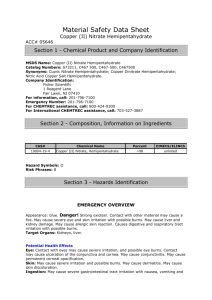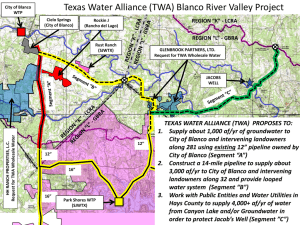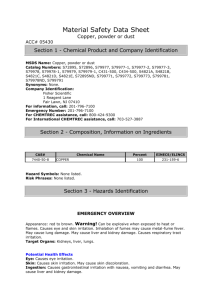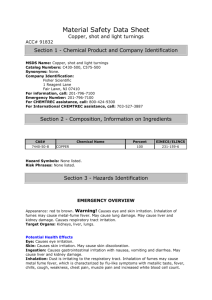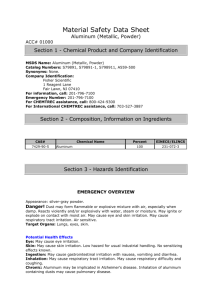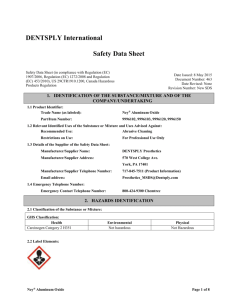Copper (II) Chloride Dihydrate MSDS: Safety & Hazards
advertisement
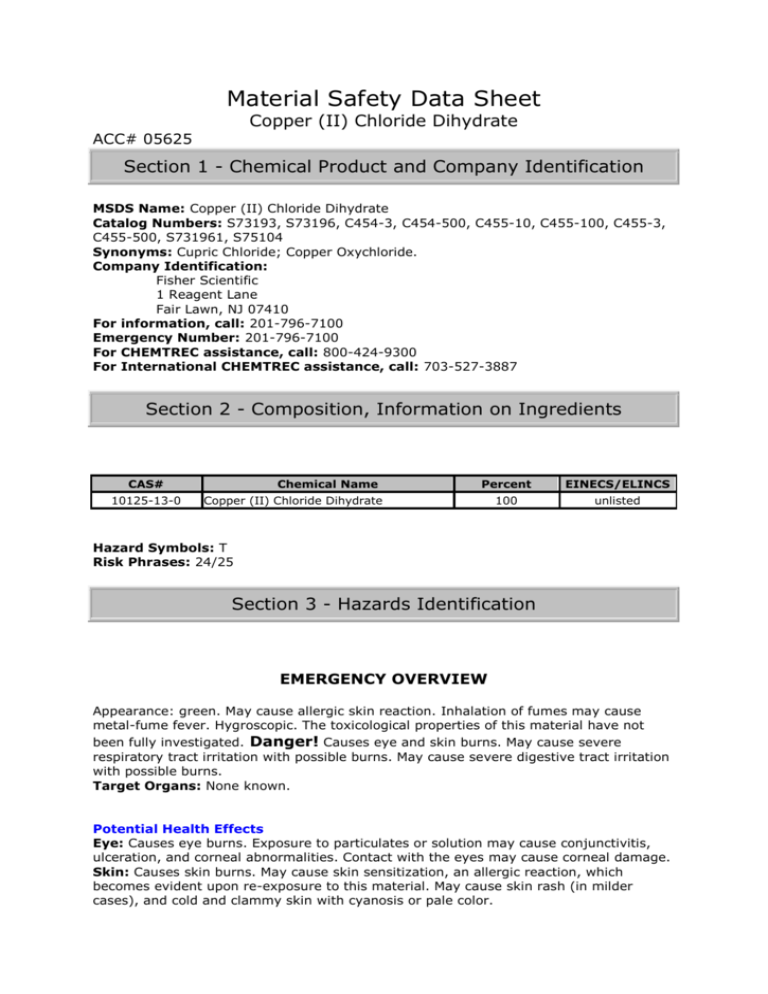
Material Safety Data Sheet Copper (II) Chloride Dihydrate ACC# 05625 Section 1 - Chemical Product and Company Identification MSDS Name: Copper (II) Chloride Dihydrate Catalog Numbers: S73193, S73196, C454-3, C454-500, C455-10, C455-100, C455-3, C455-500, S731961, S75104 Synonyms: Cupric Chloride; Copper Oxychloride. Company Identification: Fisher Scientific 1 Reagent Lane Fair Lawn, NJ 07410 For information, call: 201-796-7100 Emergency Number: 201-796-7100 For CHEMTREC assistance, call: 800-424-9300 For International CHEMTREC assistance, call: 703-527-3887 Section 2 - Composition, Information on Ingredients CAS# 10125-13-0 Chemical Name Percent EINECS/ELINCS 100 unlisted Copper (II) Chloride Dihydrate Hazard Symbols: T Risk Phrases: 24/25 Section 3 - Hazards Identification EMERGENCY OVERVIEW Appearance: green. May cause allergic skin reaction. Inhalation of fumes may cause metal-fume fever. Hygroscopic. The toxicological properties of this material have not been fully investigated. Danger! Causes eye and skin burns. May cause severe respiratory tract irritation with possible burns. May cause severe digestive tract irritation with possible burns. Target Organs: None known. Potential Health Effects Eye: Causes eye burns. Exposure to particulates or solution may cause conjunctivitis, ulceration, and corneal abnormalities. Contact with the eyes may cause corneal damage. Skin: Causes skin burns. May cause skin sensitization, an allergic reaction, which becomes evident upon re-exposure to this material. May cause skin rash (in milder cases), and cold and clammy skin with cyanosis or pale color. Ingestion: May cause severe and permanent damage to the digestive tract. Causes gastrointestinal irritation with nausea, vomiting and diarrhea. Causes gastrointestinal tract burns. May cause perforation of the digestive tract. May cause hemorrhaging of the digestive tract. The toxicological properties of this substance have not been fully investigated. May cause systemic effects. Inhalation: May cause ulceration and perforation of the nasal septum if inhaled in excessive quantities. Causes chemical burns to the respiratory tract. Inhalation of fumes may cause metal fume fever, which is characterized by flu-like symptoms with metallic taste, fever, chills, cough, weakness, chest pain, muscle pain and increased white blood cell count. The toxicological properties of this substance have not been fully investigated. Aspiration may lead to pulmonary edema. May cause systemic effects. Can produce delayed pulmonary edema. Chronic: Prolonged or repeated skin contact may cause dermatitis. Effects may be delayed. Individuals with Wilson's disease are unable to metabolize copper. Thus, copper accumulates in various tissues and may result in liver, kidney, and brain damage. Section 4 - First Aid Measures Eyes: Get medical aid immediately. Do NOT allow victim to rub or keep eyes closed. Extensive irrigation with water is required (at least 30 minutes). Skin: Get medical aid immediately. Immediately flush skin with plenty of soap and water for at least 15 minutes while removing contaminated clothing and shoes. Wash clothing before reuse. Destroy contaminated shoes. Ingestion: Never give anything by mouth to an unconscious person. Get medical aid immediately. Do NOT induce vomiting. If conscious and alert, rinse mouth and drink 2-4 cupfuls of milk or water. Inhalation: Get medical aid immediately. Remove from exposure to fresh air immediately. If breathing is difficult, give oxygen. Do NOT use mouth-to-mouth resuscitation. If breathing has ceased apply artificial respiration using oxygen and a suitable mechanical device such as a bag and a mask. Notes to Physician: Treat symptomatically and supportively. Antidote: The use of d-Penicillamine as a chelating agent should be determined by qualified medical personnel. Section 5 - Fire Fighting Measures General Information: As in any fire, wear a self-contained breathing apparatus in pressure-demand, MSHA/NIOSH (approved or equivalent), and full protective gear. During a fire, irritating and highly toxic gases may be generated by thermal decomposition or combustion. Wear appropriate protective clothing to prevent contact with skin and eyes. Wear a self-contained breathing apparatus (SCBA) to prevent contact with thermal decomposition products. Use extinguishing media appropriate to the surrounding fire. Substance is noncombustible. Extinguishing Media: Substance is noncombustible; use agent most appropriate to extinguish surrounding fire. Use water spray, dry chemical, carbon dioxide, or appropriate foam. Section 6 - Accidental Release Measures General Information: Use proper personal protective equipment as indicated in Section 8. Spills/Leaks: Vacuum or sweep up material and place into a suitable disposal container. Clean up spills immediately, observing precautions in the Protective Equipment section. Avoid generating dusty conditions. Provide ventilation. Section 7 - Handling and Storage Handling: Wash thoroughly after handling. Use only in a well-ventilated area. Minimize dust generation and accumulation. Avoid contact with eyes, skin, and clothing. Do not breathe dust, vapor, mist, or gas. Do not get in eyes, on skin, or on clothing. Keep container tightly closed. Avoid ingestion and inhalation. Do not ingest or inhale. Use with adequate ventilation. Wash clothing before reuse. Discard contaminated shoes. Storage: Keep container closed when not in use. Store in a tightly closed container. Store in a cool, dry, well-ventilated area away from incompatible substances. Store protected from moisture. Section 8 - Exposure Controls, Personal Protection Engineering Controls: Facilities storing or utilizing this material should be equipped with an eyewash facility and a safety shower. Use adequate ventilation to keep airborne concentrations low. Exposure Limits Chemical Name Copper (II) Chloride Dihydrate ACGIH none listed NIOSH OSHA - Final PELs none listed none listed OSHA Vacated PELs: Copper (II) Chloride Dihydrate: No OSHA Vacated PELs are listed for this chemical. Personal Protective Equipment Eyes: Wear appropriate protective eyeglasses or chemical safety goggles as described by OSHA's eye and face protection regulations in 29 CFR 1910.133 or European Standard EN166. Skin: Wear appropriate protective gloves to prevent skin exposure. Clothing: Wear appropriate protective clothing to prevent skin exposure. Respirators: A respiratory protection program that meets OSHA's 29 CFR §1910.134 and ANSI Z88.2 requirements or European Standard EN 149 must be followed whenever workplace conditions warrant a respirator's use. Section 9 - Physical and Chemical Properties Physical State: Solid Appearance: green Odor: odorless pH: 3.6 for 0.2 M soln. Vapor Pressure: Not available. Vapor Density: 5.9 (air=1) Evaporation Rate:Not available. Viscosity: Not available. Boiling Point: 1819 deg F Freezing/Melting Point:212 deg F Autoignition Temperature: Not applicable. Flash Point: Not applicable. Decomposition Temperature:1819 deg F NFPA Rating: (estimated) Health: 3; Flammability: 0; Reactivity: 0 Explosion Limits, Lower:Not available. Upper: Not available. Solubility: 1150 g/l (5% aq.sol.) in water. Specific Gravity/Density:2.54 (water=1) Molecular Formula:CuCl2.2H2O Molecular Weight:170.4788 Section 10 - Stability and Reactivity Chemical Stability: Stable at room temperature in closed containers under normal storage and handling conditions. Conditions to Avoid: Incompatible materials, dust generation, acids, excess heat, exposure to moist air or water. Incompatibilities with Other Materials: Alkali metals, potassium, sodium, heat, moisture. Hazardous Decomposition Products: Hydrogen chloride, irritating and toxic fumes and gases, chloride fumes. Hazardous Polymerization: Has not been reported. Section 11 - Toxicological Information RTECS#: CAS# 10125-13-0: GL7030000 LD50/LC50: Not available. Carcinogenicity: CAS# 10125-13-0: Not listed by ACGIH, IARC, NIOSH, NTP, or OSHA. Epidemiology: No data available. Teratogenicity: No data available. Reproductive Effects: No data available. Neurotoxicity: No data available. Mutagenicity: No data available. Other Studies: No data available. Section 12 - Ecological Information No information available. Section 13 - Disposal Considerations Chemical waste generators must determine whether a discarded chemical is classified as a hazardous waste. US EPA guidelines for the classification determination are listed in 40 CFR Parts 261.3. Additionally, waste generators must consult state and local hazardous waste regulations to ensure complete and accurate classification. RCRA P-Series: None listed. RCRA U-Series: None listed. Section 14 - Transport Information US DOT Shipping Name: Hazard Class: UN Number: IATA RID/ADR IMO COPPER CHLORIDE 8 Canada TDG COPPER CHLORIDE 8(9.2) UN2802 Packing Group: III UN2802 III Section 15 - Regulatory Information US FEDERAL TSCA CAS# 10125-13-0 is not on the TSCA Inventory. It is a hydrate and exempt from TSCA Inventory requirements (40CFR720.3(u)(2)). Health & Safety Reporting List None of the chemicals are on the Health & Safety Reporting List. Chemical Test Rules None of the chemicals in this product are under a Chemical Test Rule. Section 12b None of the chemicals are listed under TSCA Section 12b. TSCA Significant New Use Rule None of the chemicals in this material have a SNUR under TSCA. SARA Section 302 (RQ) None of the chemicals in this material have an RQ. Section 302 (TPQ) None of the chemicals in this product have a TPQ. SARA Codes CAS # 10125-13-0: acute, chronic. Section 313 This material contains Copper (II) Chloride Dihydrate (listed as ** undefined **), 100%, (CAS# 10125-13-0) which is subject to the reporting requirements of Section 313 of SARA Title III and 40 CFR Part 373. Clean Air Act: This material does not contain any hazardous air pollutants. This material does not contain any Class 1 Ozone depletors. This material does not contain any Class 2 Ozone depletors. Clean Water Act: None of the chemicals in this product are listed as Hazardous Substances under the CWA. None of the chemicals in this product are listed as Priority Pollutants under the CWA. None of the chemicals in this product are listed as Toxic Pollutants under the CWA. OSHA: None of the chemicals in this product are considered highly hazardous by OSHA. STATE CAS# 10125-13-0 is not present on state lists from CA, PA, MN, MA, FL, or NJ. California No Significant Risk Level: None of the chemicals in this product are listed. European/International Regulations European Labeling in Accordance with EC Directives Hazard Symbols: T Risk Phrases: R 24/25 Toxic in contact with skin and if swallowed. Safety Phrases: S 20 When using do not eat or drink. S 37 Wear suitable gloves. S 44 If you feel unwell, seek medical advice (show the label where possible). WGK (Water Danger/Protection) CAS# 10125-13-0: No information available. Canada Canada None of the chemicals in this product are listed on the DSL or NDSL list. This product has a WHMIS classification of E. CAS# 10125-13-0 is not listed on Canada's Ingredient Disclosure List. Exposure Limits CAS# 10125-13-0 (listed as ** undefined **): OEL-ARAB Republic of Egyp t:TWA 0.1 mg/m3 (fume) OEL-AUSTRALIA:TWA 0.2 mg/m3 (fume) OEL-AUSTRA LIA:TWA 1 mg/m3 (dust) OEL-BELGIUM:TWA 0.2 mg/m3 (fume) OEL-BELGIUM: TWA 1 mg/m3 (dust) OEL-DENMARK:TWA 0.1 mg/m3 (fume) OEL-DENMARK:TWA 1 mg/m3 (dust) OEL-FINLAND:TWA 0.2 mg/m3 (fume) OEL-FINLAND:TWA 1 mg /m3 OEL-FINLAND:TWA 1 mg/m3 (dust) OEL-FRANCE:TWA 0.2 mg/m3 (fume) OEL-FRANCE:TWA 1 mg/m3;STEL 2 mg/m3 (dust) OEL-GERMANY:TWA 0.1 mg/m3 (fume) OEL-GERMANY:TWA 1 mg/m3 OEL-GERMANY:TWA 1 mg/m3 (dust) OEL-H UNGARY:TWA 0.2 mg/m3;STEL 0.4 mg/m3 (dust) OEL-INDIA:TWA 0.2 mg/m3 (f ume) OEL-THE NETHERLANDS:TWA 02 mg/m3 (fume) OEL-THE NETHERLANDS:TWA 1 mg/m3 (dust) OEL-THE PHILIPPINES:TWA 1.0 mg/m3 (fume) OEL-POLAND: TWA 0.1 mg/m3 (fume) OEL-RUSSIA:STEL 0.5 ppm (1 mg/m3) (dust) OEL-SW EDEN:TWA 0.2 mg/m3 (resp. dust) OEL-SWEDEN:TWA 0.2 mg/m3 (fume) OELSWEDEN:TWA 1 mg/m3 (total dust) OEL-SWITZERLAND:TWA 0.1 mg/m3;STEL 0. 2 mg/m3 (fume) OEL-SWITZERLAND:TWA 1 mg/m3;STEL 1 mg/m3 OEL-THAILAND :TWA 0.1 mg/m3 (fume) OEL-THAILAND:TWA 1 mg/m3 OEL-UNITED KINGDOM:TW A 0.2 mg/m3 (fume) OEL-UNITED KINGDOM:TWA 1 mg/m3 OEL IN BULGARIA, C OLOMBIA, JORDAN, KOREA check ACGIH TLV OEL IN NEW ZEAL Section 16 - Additional Information MSDS Creation Date: 6/09/1999 Revision #5 Date: 10/06/2000 The information above is believed to be accurate and represents the best information currently available to us. However, we make no warranty of merchantability or any other warranty, express or implied, with respect to such information, and we assume no liability resulting from its use. Users should make their own investigations to determine the suitability of the information for their particular purposes. In no event shall Fisher be liable for any claims, losses, or damages of any third party or for lost profits or any special, indirect, incidental, consequential or exemplary damages, howsoever arising, even if Fisher has been advised of the possibility of such damages.


